SUMMARY OF FINDINGS
In June 2015, the number of actively trading businesses in the market sector (2,121,235) had increased by 1% from June 2014 levels. While there were slight reductions in the number of business entry and exit rates in 2014-15 from 2013-14 (business entry rate 13.7% to 13.4% and business exit rate from 12.7% to 12.4%), it is the second consecutive year that business counts increased by 1%.
Similar to population growth, Victoria recorded the largest annual increase in business counts (1.6% from June 2014 to June 2015). Tasmania was the only jurisdiction to record a decrease in business counts (-0.7%) over this reporting period and has also recorded decreases in each of the years reported on in this publication. Tasmania has the highest proportion of businesses in the Agriculture, Forestry and Fishing Industry Division (15.5%) followed by South Australia (12.6%) and then Queensland (10%). These states have also recorded the largest decrease in business counts from June 2011 to June 2015. Nationally, the Agriculture, Forestry and Fishing Industry Division has seen business counts declining for the four years reported on in this publication (-2.4% decrease from June 2014 to June 2015 and -9.8% from June 2011 to June 2015).
The Financial and Insurance Services Industry Division is the fastest growing Industry Division. The Industry Class of Superannuation Funds is part of the Financial and Insurance Services Industry Division and recorded the highest net increase in counts (7,242 businesses). Excluding this Industry Class, the Financial and Insurance Services Industry Division count of businesses actively trading in the market sector would have declined. Beef Cattle Farming (Specialised) of the Agriculture, Forestry and Fishing Industry Division recorded the largest net decrease in Industry Class business counts (-1,208) from June 2014 to June 2015.
Companies and Trusts continue to be more prominent Types of Legal Organisation (3.1% and 3.2% net increase in business counts respectively from June 2014 to June 2015) as sole proprietorships and partnerships continue to decrease (-1% and -4.1% net decrease in business counts respectively from June 2014 to June 2015). These results are part of a longer term trend with counts of Companies and Trusts increasing by 9.7% and 10.1% respectively from June 2011 to June 2015, while business counts of Sole proprietorships and Partnerships have reduced by 11.7% and 15.7% over the same period.
Non-financial Corporations accounted for 30.4% of the businesses in the Institutional Sector in June 2011, Financial Corporations 7.5% and Households 60.4%. While Households continue to be the largest Institutional Sector (56.2% of businesses at June 2015), the latest net decrease in business counts (-0.7% from June 2014 to June 2015) for this sector is part of a continuing decline. In June 2015 non-financial corporations grew to represent 33.6% of Australian business actively trading in the market sector and financial corporations moved to 8.5%.
OF THE INDUSTRY DIVISIONS
- Construction had the most businesses operating in Australia in June 2015.
- Electricity, Gas, Water and Waste Services had the fewest businesses operating in Australia in June 2015.
- Accommodation and Food Services had the highest business entry rate in 2014-15.
- Agriculture, Forestry and Fishing had the lowest business entry rate in 2014-15.
- Public Administration and Safety had the highest business exit rate in 2014-15.
- Health Care and Social Assistance had the lowest business exit rate in 2014-15.
- Health Care and Social Assistance businesses were the most likely to survive from June 2011 to June 2015.
- Public Administration and Safety businesses were the least likely to survive from June 2011 to June 2015.
Survival rates of businesses that started in 2011-12
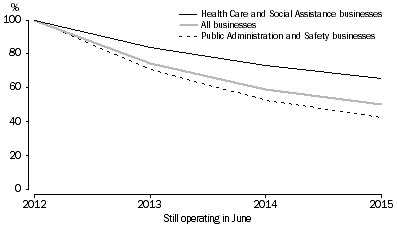
OF THE STATES AND TERRITORIES
- Counts of businesses mainly operating in Tasmania reduced in June 2015 from June 2014, while all other states and territories increased.
- The Australian Capital Territory had both the highest business entry rate and the highest business exit rate in 2014-15.
- Businesses mainly operating in Tasmania were the most likely to survive from June 2011 to June 2015.
- Businesses mainly operating in the Australian Capital Territory were the least likely to survive from June 2011 to June 2015.
Actively trading businesses by main state/territory of operation
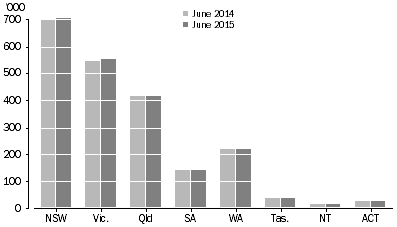
OF THE INSTITUTIONAL SECTORS
- Most businesses actively trading in Australia in June 2015 were unincorporated businesses owned and operated by the household sector.
- Between June 2014 and June 2015, the number of non-financial corporations and financial corporations increased while the number of household sector businesses decreased.
- The financial corporations sector had the highest business entry rate in 2014-15.
- The household sector had the highest exit rate in 2014-15.
- Financial corporations were the most likely to survive from June 2011 to June 2015.
- Financial corporations that started operating in 2011-12 were the most likely to have still been operating in June 2015.
Institutional sector of actively trading businesses
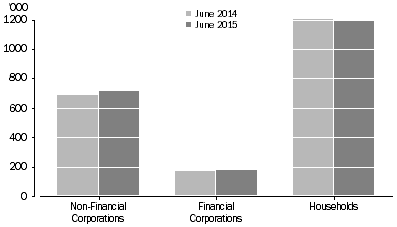
OF THE TYPES OF LEGAL ORGANISATION
- Public sector businesses were the least common, with only 500 actively trading goods or services in Australia in June 2015.
- Between June 2014 and June 2015, the number of actively trading companies and trusts increased while the number of actively trading sole proprietors, partnerships and public sector businesses each decreased.
- In 2014-15, business entry and exit rates were highest for sole proprietors.
- Trusts were the most likely to survive from June 2011 to June 2015.
Type of legal organisation of actively trading businesses
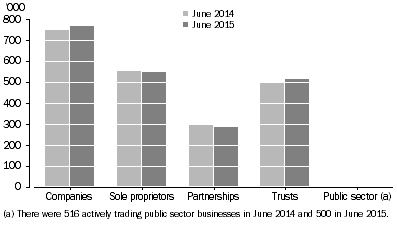
OF THE EMPLOYMENT SIZE RANGES
- In June 2015, 61% of actively trading businesses in Australia had no employees, 28% had 1-4, 9% had 5-19, 2% had 20-199, and less than 1% had 200 or more.
- Among businesses operating in both June 2014 and June 2015, there was net movement away from having 1-19 employees in June 2014 towards either having no employees or having more than 19 employees in June 2015.
- The more employees an ongoing business had in June 2011 the more likely it would survive.
- For a business that started operating in 2011-12, the more employees it had in June 2012 the more likely it was to still be operating in June 2015.
- In 2014-15, business entry and exit rates were highest for businesses with no employees.
Business entry and exit rates by number of employees - 2014-15
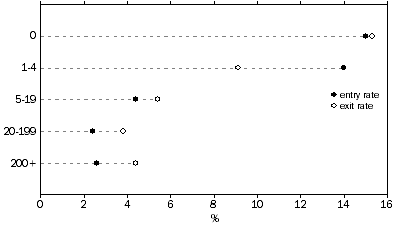
OF THE TURNOVER SIZE RANGES
- In June 2015, most actively trading businesses had annual turnover under $200,000.
- Among businesses operating in both June 2014 and June 2015, there was net movement away from having annual turnover of between $50,000 and under $2 million in June 2014, towards having annual turnover of either less than $50,000 or at least $2 million in June 2015.
- The more turnover a business had in June 2011 the more likely it would survive.
- Businesses that started operating in 2011-12 with annual turnover of at least $2 million were most likely to survive.
- In 2014-15, business entry rates were highest for businesses with annual turnover of between $50,000 and $199,999 and lowest for businesses with annual turnover of $2 million or more.
- In 2014-15, business exit rates were highest for businesses with annual turnover under $50,000 and lowest for businesses with annual turnover of $2 million or more.
Business entry and exit rates by annual turnover - 2014-15
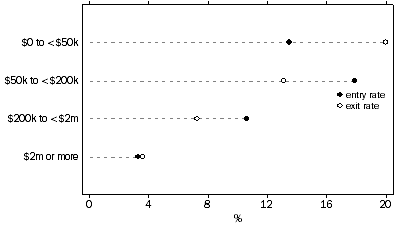
More business demography data are available in Excel spreadsheets available from the Downloads tab.
 Print Page
Print Page
 Print All
Print All
 Quality Declaration
Quality Declaration